Canon EOS R50 V Review

The Canon EOS R50 V is an entry-level, easy-to-use, interchangeable lens mirrorless camera prioritized for video capture. This compact, lightweight camera delivers excellent still and movie image quality, especially for the low price. The R50 V is a great starter camera, including for kids.
- Excellent still and movie image quality
- Power zoom switch
- Easy to use
- Compact, lightweight, affordable
- Well connected
- No EVF
- Moderate rolling shutter effect
- Intro
- Summary of Canon EOS R50 V Features
- Sensor and Image Quality
- File Size and Media
- Frame Rate, Buffer Depth, Shutter
- Autofocus
- Movies
- Exposure/Metering System
- Viewfinder and LCD
- Physical Design
- Size of the Camera
- Ergonomics, Build Quality, and Durability
- Additional Features
- Battery
- Optional Accessories
- What is the Best Lens for the Canon EOS R50 V?
- Price
- Wrap Up
- Alternatives
- Summary
- B&H Photo(strongly recommended)
- Adorama
- Amazon.com
- Canon USA
 Wex Photographic
Wex Photographic Camera Canada
Camera Canada- eBay (choose trustworthy sellers only)
- Check the used inventory at:
B&H | KEH | Adorama | MPB - Rent it here: Lensrentals.com
The R50 V is the first Canon EOS R-series interchangeable lens camera to receive the "V" designation, denoting its video-priority design.
As a generalization, the higher the number following the "R", the lower the camera is positioned in the product lineup. "50" is a relatively high number, and this entry-level camera has affordability as a strong feature, yet as an R-series camera, it provides access to Canon's incredible lineup of RF lenses.
The R50 V's image quality is excellent, and its compact size, light weight, and easy-to-use design appeal to videographers of all skill levels.
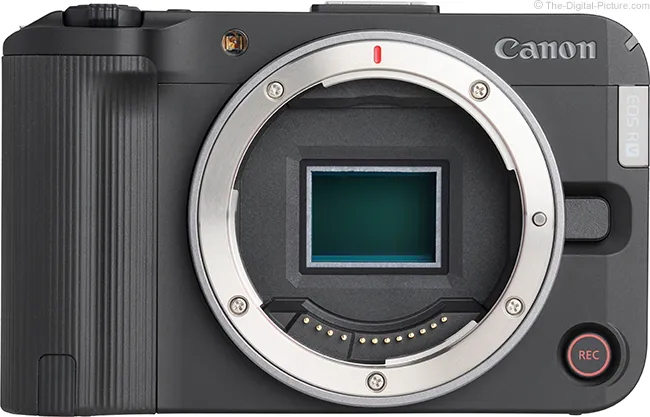
Summary of Canon EOS R50 V Features
Back to Top
- 24.2 MP APS-C CMOS Image Sensor
- Impressive Dual Pixel CMOS AF II tracking with Register People Priority and Auto People, Animal, and Vehicle Subject Detection
- AF working range EV -5.0-20
- DIGIC X Image Processor
- High-Speed Continuous Shooting at up to 12 fps with the 1st curtain mechanical shutter (full mechanical shutter is not available), 15 fps with the electronic shutter
- up to 1/8000 electronic shutter, up to 1/4000 1st curtain shutter
- First EOS V series camera body
- Interchangeable lens movie recording
- Creator-centric interface. including a vertical video tripod mount and front record button
- Up to 4K Crop 59.94p, 4K 29.97p full-width (from 6k) and Full-HD full-width 119.8p recording, 2 hr. max record time
- Slow and Fast mode for creative control of the video frame rate and playback speed
- Advanced Video features such as Canon Log 3, HLG, PQ, 709 Recording, False Color and Zebras
- Easy to use Automatic Exposure and Scene modes such as Movie for Close-up demo, Smooth Skin and Movie IS mode, as well as Color Filters
- Multi-function accessory shoe with support of LPCM 24bit/4ch audio
- Tally Lamp
- Movie Color Filters
- False Color
- Wi-Fi (2.4GHz, 5GHz), Bluetooth (5.1)
- 4 built-in Live streaming modes for easy connection to your audience — UVC/UAC, HDMI, Camera connect, Live Switcher mobile
- 3.0" 1.04m-Dot Vari-Angle Touchscreen
- ISO 100-32000, Expandable up to 51200
- Headphone port
- Super-Speed Plus USB (USB 3.2 Gen 2)
- E3 remote port
- Interval timer
- UHS-II SC card support
- No EVF, no IBIS, no built-in flash, not weather sealed
- Compact, lightweight, affordable
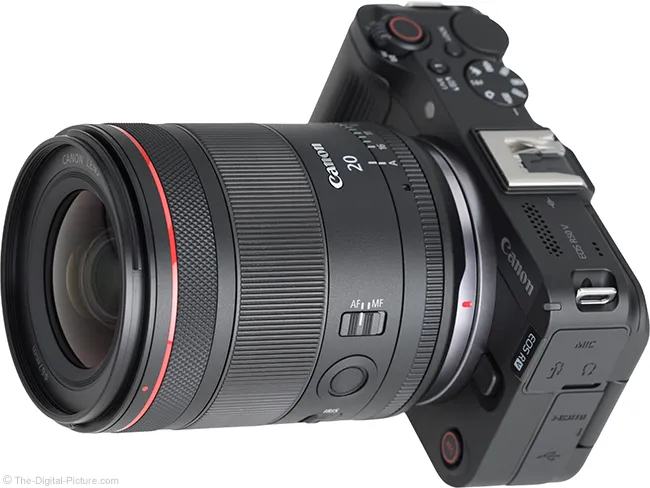
Sensor and Image Quality
Back to TopThe R50 V gets Canon's APS-C (1.6x field of view crop factor) 24.2 MP CMOS imaging sensor (not backside-illuminated (BSI) and not stacked), first seen in the R10 and also featured in the R50. While numerous other Canon EOS APS-C cameras share this resolution, only these 3 models share this imaging sensor at review time.
| Model | FOVCF | Sensor | Pixel Size | Pixels/Megapixels | DLA* | |
|---|---|---|---|---|---|---|
| Canon EOS R10 | 1.6x | 22.3 x 14.9mm | 3.72µm | 6000 x 4000 | 24.2 | f/6.0 |
| Canon EOS R50 | 1.6x | 22.3 x 14.9mm | 3.72µm | 6000 x 4000 | 24.2 | f/6.0 |
| Canon EOS R50 V | 1.6x | 22.3 x 14.9mm | 3.72µm | 6000 x 4000 | 24.2 | f/6.0 |
| Canon EOS R100 | 1.6x | 22.3 x 14.9mm | 3.72µm | 6000 x 4000 | 24.1 | f/6.0 |
| Canon PowerShot V1 | 2.0x | 18.4 x 12.3mm | 3.2µm | 5760 x 3840 | 22.3 | f/5.2 |
The R50 V's 24.2 MP resolution is substantial, the same as Canon's highest performing MILC, the EOS R1.
Also substantial is the size of the APS-C imaging sensor, illustrated in relation to other standards below.

Available ISO settings are 100-32000, expandable up to 51200 for stills, and 100-12800, expandable up to 16000-25600 for movies.
Camera image quality testing is time-consuming, and the R50 V has the same image quality as the R10 and R50. Thus, it didn't make sense to complete a full round of tests for the R50 V. Read the Canon EOS R50 image quality section to get the details, but this imaging sensor delivers excellent performance. Noise levels are low, and dynamic range is high.
This camera relies on the lens to provide optical stabilization. Fortunately, a significant percentage of RF lenses provide this feature. The camera offers digital IS.

File Size and Media
Back to TopThe Canon EOS R50 V writes image files to an SD/SDHC/SDXC (UHS-II) memory card. This long-established card format is compact, affordable, highly compatible, and ubiquitous.
Introduced with the Canon EOS M50 was the .CR3 RAW format, and the Canon EOS R50 V gets this feature. This RAW file format enables new features, including C-RAW, compressed RAW with lossy compression vs. the normally compressed RAW with non-lossy compression.
C-RAW provides full RAW file support along with an estimated 40% file size reduction over Canon's already efficient RAW file format size. The saved space adds up quickly, significantly impacting memory card and hard disk storage capacity requirements.
As usual, JPG (8-bit) and HEIF (10-bit) file formats are supported.

Frame Rate, Buffer Depth, Shutter
Back to TopThe Canon EOS R50 V supports reasonably fast shooting rates — up to 12 fps continuous shooting using the first curtain electronic shutter (full mechanical shutter is not available) and 15 fps using the first curtain electronic shutter, while retaining full autofocus and autoexposure functionality. While some MILCs are faster, the 15 fps second performance is still impressive. 15 fps is only 1 fps slower than Canon's best-ever DSLR, the EOS-1D X Mark III, when used with the viewfinder.
Sometimes the difference between an average image and a great one is separated by milliseconds, and at 15 fps, this camera stands a good chance of catching the perfect peak action moment.
Here is the Canon EOS R50 V drive mode and continuous shooting rate table:
| Shutter/Drive Mode | Hi+ | Hi | Low |
| Electronic | 15 | 15 | 5 |
| Elec 1st Curtain | 12 | 7.6 | 3 |
These are up-to rates, with battery power level, battery type, lens model, Dual Pixel RAW shooting, temperature, shutter speeds, etc., potentially affecting the realized rate. This camera does not feature RAW burst mode or Pre-Shooting.
RAW and C-RAW files have 14-bit A/D conversion with the electronic 1st curtain shutter, and 12-bit A/D conversion is provided with the full electronic shutter.
| Model | FPS | Max JPG | Max RAW | Shutter Lag | VF Blackout |
|---|---|---|---|---|---|
| Canon EOS R10 | 15/23 | 460/70 | 29/21 | 50-100ms | n/a |
| Canon EOS R50 | 12/15 | 42/28 | 7 | ||
| Canon EOS R50 V | 12/15 | 95 | 36 | ||
| Canon EOS R100 | 6.5 (3.5) | 100 | 6 | ||
| Canon PowerShot V1 | 15/30 | >400/45 | 61/30 |
Max continuous shooting capacity was quite limited on the R50, but the R50 V significantly improves upon that camera's capabilities, providing over 2 seconds of 15 fps RAW image capture. Use the C-RAW file format to significantly exceed the RAW spec.
This camera's imaging sensor readout speed is considerably faster than that of the R100 and similar to the R50 and R10, which is mediocre.
| Model (times in ms) | Electronic | 1st Curtain Mechanical |
|---|---|---|
| Canon EOS R10 | 35.0 | 2.8 |
| Canon EOS R50 | 35.3 | 2.4 |
| Canon EOS R50 V | 33.0 | 2.4 |
| Canon EOS R100 | 78.0 | 2.4 |
| Canon PowerShot V1 | 23.0 |
The R50 V goes to 1/8000 with the electronic shutter and up to 1/4000 with the 1st curtain electronic shutter selected. X-Sync is 1/250 electronic (1st curtain only).
The EOS R50 V has a built-in intervalometer (interval timer).

Autofocus
Back to TopGetting great images requires high precision focusing, and Canon's latest AF systems have changed the photography and videography games. These outstanding performing cameras, featuring incredible subject tracking and eye detection in conjunction with fast frame rates, make getting what used to be a trophy shot into a routine occurrence.
With the latest Canon Dual Pixel CMOS AF system, the photographer is often freed to focus on composition and shutter release timing, letting the camera handle AF. Impressive is that the technology from the high-end EOS AF systems gets reused in low-priced EOS camera models.
As in Canon's most recent AF systems, People (Eyes/Face/Head/Body), Animals (Dogs, Cats, Birds, and Horses), or Vehicles (Racing cars, Motor bikes, aircraft, and trains) can be specified, and the camera tenaciously stays locked on these subjects. Not sure which subject you will be photographing, changing subjects frequently, or concerned that you will forget to change to the proper subject? Select the "Auto" option. It works great.
The camera will also superbly track a non-recognized subject when it is focused on.
The EOS R50's Dual Pixel CMOS AF system features Spot AF (AF can be selected from 4503 available positions for stills, 3713 for Movies), 1-point AF, AF point Expansion 4 points (up, down, left, right), AF point Expansion surrounding (all surrounding points), Flexible Zone AF 1-3, and Whole Area AF (entire focusing area with 1053 maximum focusing zones). Note that, when enabled, subject tracking in Servo AF mode will take over the AF point selection once the subject is established. Turn off tracking to lock AF to the selected point or area.
AF coverage is up to approx. 100% x 100% of the frame, though coverage can vary depending on the lens used. Generally, only very narrow aperture lenses and lens plus extender combinations cause reduced coverage. Those coming from a DSLR will find the ability to maintain continuous focus with a point in the periphery of the image to be game-changing.
Selecting a single focus point out of the extreme number of points available on this camera is made simple by touchscreen.
The R50 V can AF at EV -5 – 20 (EV -2.5 to 20 for movies). EV -5 is super dark, and that performance is without aid from the AF assist lamp. Located on the camera's right side is a bright LED focus assist lamp that extends AF capabilities into complete darkness within its range. A lens hood can partially block this light, so hood removal is sometimes optimal, depending on the focus point selected and the amount of reflected assist light available for the selected point.
The R50 V focuses fast, and this advanced AF system suits practically all pursuits.
Most review-time-current sensor-based AF systems do not provide cross-sensitive AF point technology. As a result, the R50 camera may struggle to focus on only perfectly horizontally oriented lines of contrast. That said, I seldom encounter this issue with any R-series cameras, and rolling the camera slightly until focused usually resolves AF lock-on issues.

Focus Bracketing (illustrated with a different camera) is a useful R50 V feature. Learn more on the Canon Focus Bracketing page.
Canon's latest AF systems, including the R50 V's, are outstanding performers.
Movies
Back to TopWith a "V" added to the R50's product name, we expect that video functionality has been prioritized and improved. The video optimized controls and control layout make that emphasis obvious, but the changes go considerably deeper.
The R50 V is capable of up to 4K Crop 59.94p, 4K 29.97p full-width from 6k, and Full-HD full-width 119.8p recording.
Supported movie types are:
XF-HEVC S YCC422 10 bit, H.265 / HEVC, YCbCr 4:2:2, MP4
XF-HEVC S YCC420 10 bit, H.265 / HEVC, YCbCr 4:2:0, MP4
XF-AVC S YCC 422 10 bit, H.264 / MPEG-4 AVC, YCbCr 4:2:0, MP4
XF-AVC S YCC 420 8 bit, H.264 / MPEG-4 AVC, YCbCr 4:2:0, MP4
Available movie sizes and framerates are:
4K UHD (3840 x 2160): 59.94, 50.00, 29.97, 25.00, 23.98 fps
Full HD (1920 x 1080): 119.88, 100.00, 59.94, 50.00, 29.97, 25.00, 23.98 fps
1/4-speed slow-motion movie recording is supported.
Canon Log 3 is supported.
The max recording duration is 2 hours (excluding High Frame Rate movies).
Close-up demo mode changes focus to a product held up to the camera (auto settings only). Smooth Skin mode makes ... skin smooth. Color filters are available.
The R50 V has a built-in mic, along with mic and headphone ports. An HDMI Micro OUT terminal (Type D) port is provided.
Dual Pixel CMOS AF II with subject and eye detection and tracking is available during movie recording, and it works impressively well. 5-axis Movie Digital IS aims to steady video recording, especially for big movements, and coordinates with in-lens image stabilization.
Expect to see a moderate rolling shutter effect when panning with the R50 V, but, as usual for EOS R-series camera video, the video quality is excellent, especially at 4K.
Exposure/Metering System
Back to TopThe EOS R50 V's high-performing metering system features 384 zones (24x16), and the metering range specification is good: EV -2 – 20 for stills and EV 0 to 20 for movies.
This camera's metering modes include Evaluative metering (AF point-linked), Partial metering (approx. 5.8% of the area at the center of the screen), Spot metering (approx. 2.9% of the area at the center of the screen), and Center-weighted average metering. Exposure compensation is +/-3 stops in 1/3-stop (but not 1/2-stop) increments.
AEB (Auto Exposure Bracketing) uses those same numbers with 3 shots available.
I continue to be impressed by EOS cameras' metering capabilities, and the R50 V's metering system proved reliable. While I still use manual mode 95% of the time, I rely on the camera's metering via Auto ISO an increasing percentage of the time.
Related to metering is Canon's Anti-flicker mode, a game-changer when photographing under flickering lights, especially when photographing fast action.
Viewfinder and LCD
Back to TopThe EOS R50 V does not have a viewfinder, and I miss it for stills.
The EOS R50 features Canon's 2.95" (7.50cm) Clear View LCD II, featuring approx. 1.04 million dot Vari-angle Touchscreen LCD. The Vari-angle feature of this LCD permits rotation of nearly 180° horizontally and 270° vertically, making hard-to-get shots and unique perspectives (including selfies and vlogging) easy to capture.
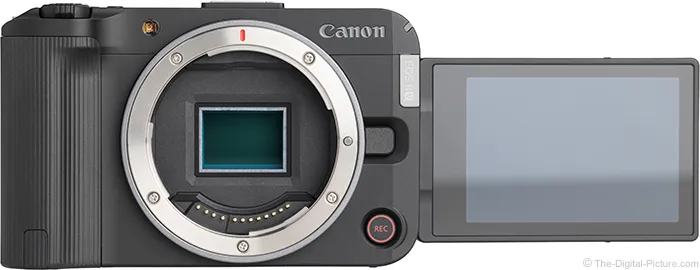
While this is a relatively low-resolution LCD display, the image quality is nice. The LCD is difficult to use in bright light, and some of us require corrective glasses for clarity.
Anti-smudge coating is not applied, making this LCD modestly more difficult to clean than models featuring this coating.
Canon's touchscreens make changing camera settings easy, including via the always excellent Canon menu structure and the handy "Q" button (showing the Quick Control screen).
Physical Design
Back to TopThe R50 V features a vastly new for EOS R camera design that is optimized for the video content creator. The EVF is gone, and the shape is an efficient, modestly rounded rectangular block.
Use the site's camera product image comparison tool to visually compare the Canon EOS R50 V with many other camera models.
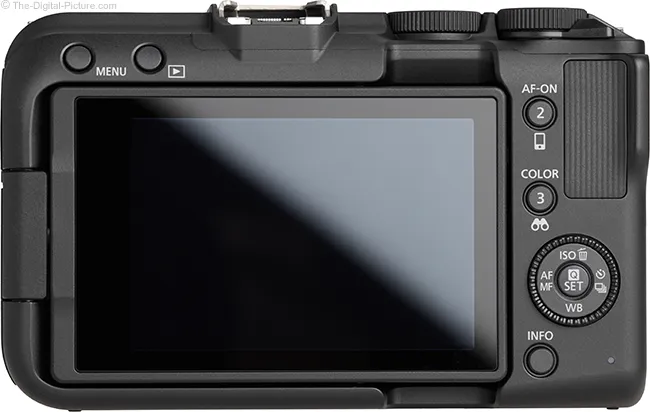
Back of the Camera
The LCD consumes most of the back of the R50 V. Also included are five buttons and a multi-controller, compactly enabling significant functionality, including a dial, four cross keys, and a center button, in a small space.
The buttons are slightly raised for easy locating and use, and in cinema fashion, two of them feature numbers. The multi-controller is superbly designed and also easy to use.
The thumb space is small, but the significant ridge enables a sure grip.
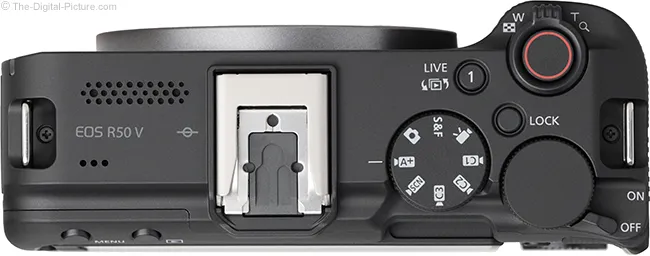
Top of the Camera
In reverse of normal for the EOS R series, the mode dial has only one stills setting. With no movie/stills switch, the LCD must be used to select the stills settings.
The lack of markings on the other top dial enables it for varied and customizable uses.
Both top dials are attractively recessed, which provides protection.
The power switch is protected yet easy to turn on, where it is even more recessed. Turning the switch off requires a bit more determination, which is often a good thing.
A power zoom switch surrounds the top shutter release/start/stop button. Pushed slightly, this lever zooms a power zoom lens (only) slowly, ideal for careful composition and for zooming during video recording. Pushing the lever slightly more enables fast zooming. When using the camera's menu, the power zoom lever selects the next or previous tab.
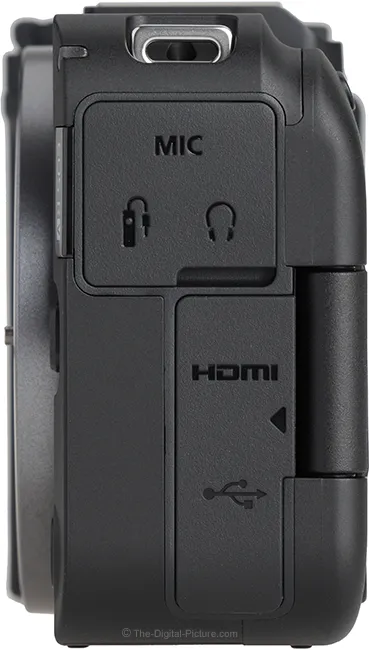
Side of the Camera
The left side of the camera features mic and headphone ports, an E3 remote port, an HDMI Micro OUT terminal (Type D), and a Hi-Speed USB 3.2 USB Type-C connector.
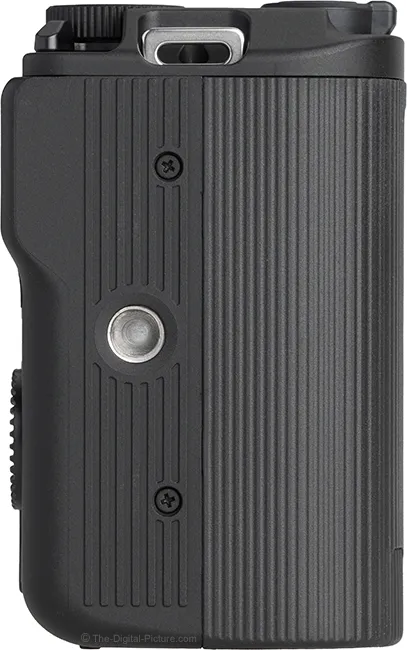
The right side of the camera features a threaded tripod insert, ideal for vertical video use.

Front of the Camera
Notable on the front of this camera is the start/stop button that is easy to use from the front, including when recording vertical video.
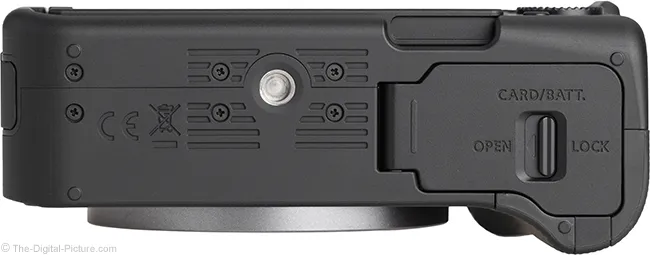
Size of the Camera
Back to TopAt its release, the R50 V is the smallest EOS R camera ever.
| Model | Body Dimensions | CIPA Weight | |
|---|---|---|---|
| Canon EOS R10 | 4.8 x 3.5 x 3.3" | (122.5 x 87.8 x 83.4mm) | 15.1 oz (429g) |
| Canon EOS R50 | 4.6 x 3.4 x 2.7" | (116.3 x 85.5 x 68.8mm) | 13.3 oz. (375g) |
| Canon EOS R50 V | 4.7 x 2.9 x 1.8" | (119.3 x 73.7 x 45.2mm) | 13.0 oz. (370g) |
| Canon EOS R100 | 4.6 x 3.4 x 2.7" | (116.3 x 85.5 x 68.8mm) | 12.6 oz. (356g) |
| Canon PowerShot V1 | 4.7 × 2.7 × 2.1" | (118.3 × 68.0 × 52.5mm) | 15.0 oz. (426g) |
The EOS R100 is lighter, but few of us would notice the 0.4 oz (14g) difference.
Ergonomics, Build Quality, and Durability
Back to TopThe R50 V features the usual EOS high build quality. This camera is solid, and the controls have a high-quality feel.
Despite the camera's small size, its well-designed grip makes it handle well in my large hands.
The EOS R50 V does not have specified weather resistance. I recommend using a rain cover when dust and moisture are expected.
The R50 V does not close the shutter when powered down.
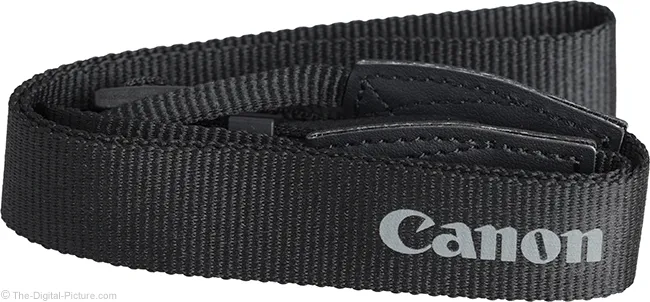
Additional Features
Back to TopThe Canon PowerShot V1 has built-in Wi-Fi (2.4GHz and 5GHz) and Bluetooth (5.1), providing easy remote control of the camera, along with viewing, transferring, and sharing of images and movies to compatible mobile devices using Canon's free Camera Connect app (iOS | Android).
USB or Wi-Fi support Full HD streaming, and the R50 V is compatible with the Canon Live Switcher Mobile app, which allows wireless connection, control, and switching between up to three cameras for live streaming.
The Multi-function shoe enables accessories in addition to flashes, including the Canon DM-E1D Stereo Microphone.
The R50 does not have a self-cleaning sensor.
Battery
Back to TopThe R50 V is powered by the small Canon LP-E17 Battery Pack, which powers numerous other compact Canon cameras. The small LP-E17 is CIPA rated for 480 shots.
The Canon LP-E17 Battery Charger is included.
Compatible and power-related are the Canon USB Power Adapter PD-E1 (USB power), AC Adapter AC-E6N, AC Adapter Kit ACK-E18, and DC Coupler DR-E18.
Optional Accessories
Back to TopUtilizing this camera's Bluetooth capability is the Canon BR-E1 Remote, which is capable of zooming (power zoom lenses only), initializing AF, and controlling the shutter, including starting and stopping video recording. The BR-E1 is available with another useful accessory, the Canon HG-100TBR Tripod Grip.

What is the Best Lens for the Canon EOS R50 V?
Back to TopA lens can make a big difference in a camera's overall performance and resulting image quality, and the growing, directly compatible Canon RF Lens lineup is impressive.
The EOS R50 V is available in a body-only kit or a kit with the Canon RF-S 14-30mm F4-6.3 IS STM PZ Lens. This lens maintains the spirit of the camera, featuring a focal length range ideal for self-recording, the power zoom feature, and image quality that delivers above its price tag.
Browse the site's Canon lens recommendations for more options.
Price
Back to TopThe low, entry-level price is one of this camera's best features.
Wrap Up
Back to TopKeeping a review of the incredibly feature-laden R50 V concise but complete is a difficult balance, and this review does not cover every R50 V feature available. Canon published an extensive owner's manual (a link to the manual is provided with this review) that highlights all the features found in this camera and explains their use. Read the manual, use the camera, repeat.
Owning a Canon product provides access to Canon support, and the Canon USA division's support is excellent (sorry, I have no experience with the other Canon divisions). When I call for support, I get an intelligent person who sincerely wants to help answer the question or resolve the problem. Canon repair service, though I seldom need it, is fast and reliable.
The R50 V used for this review was ordered online retail.

Alternatives
Back to TopAn obvious Canon EOS R50 V camera comparison is against the Canon EOS R50. Physically, these cameras appear to be completely different, unrelated. However, their names, differing by only the "V", suggest a strong relationship.
Image quality is one aspect these cameras share, and entry-level pricing is another. Still, the differences are vast.
Here are the R50 V's advantages:
- Greater stills buffer — JPEG 140, RAW 59 vs. 42, 7
- Video codec XF-HEVC S and XF AVC-s vs. MP4
- 4K/4K Crop and Full HD vs. 4K and Full HD
- Addition of Full HD 119.88 fps
- Standard Intra and Standard LGOP vs. IPB/IPB Light
- Slow and Fast movie mode
- Cinema View
- Smooth Skin Movie
- 4K Timelapse Movie
- 24-bit 4ch audio vs. 16-bit 2ch
- Tally Lamp and recording emphasis
- 2 hr. Max record time vs. 1 hr.
- Movie Color Filters vs. none
- Custom Picture vs. none
- AF working range EV -5.0-20 vs. EV -4.0-20
- Metering range EV -5.0-20 (-2.5-20 for video) vs. EV -2.0-20
- UHS-II SD card support vs. UHS-I
- Register people Priority
- Detect Priority AE while AF vs. none
- False Color for Movie
- Interval timer built in vs. none
- Headphone port vs. none
- E3 remote port vs. none
- Bluetooth 5.1 vs. 4.2
- Super-Speed Plus USB (USB 3.2 Gen 2) vs. Hi-Speed USB 2.0
- UVC/UAC, HDMI, Camera connect, Live Switcher mobile vs none
- Smaller — 4.7 x 2.9 x 1.8" vs. 4.58 x 3.37 x 2.71" (119.3 x 73.7 x 45.2mm vs. 116.3 x 85.5 x 68.8mm)
- Modestly lower list price (though discounting may impact street price)
Special thanks to Canon USA's Drew MacCallum for providing most of this rather long list.
Here are the R50's advantages:
- Has an EVF
- Higher resolution 1.62 million dot LCD vs. 1.04
- Built-in flash
The controls and control layout differ considerably between the two camera models, including the mode dial optimized for stills or video, and a zoom lever on the R50 V.
The generalized recommendation comes back to the "V". Those primarily interested in capturing video will want the R50 V, and those focusing on stills may appreciate the R50's EVF over the V's advantages.
Summary
Back to TopThe Canon EOS R50 V is an ideal choice for the creator stepping up from a smartphone or an advanced videographer who needs a compact, lightweight camera. The R50 V's design highly favors movie capture, but it is a highly qualified still camera as well.

This camera travels well and adds little weight to the bag or hand.
The affordable R50 V's image quality is excellent, and its compact size, light weight, and easy-to-use design appeal to videographers of all skill levels. Not only is the Canon EOS R50 V a great starter camera for adults, but it is an ideal choice for kids.
Bringing you this site is my full-time job (typically 60-80 hours per week). Thus, I depend solely on the commissions received from you using the links on this site to make any purchase. I am grateful for your support! - Bryan
- B&H Photo(strongly recommended)
- Adorama
- Amazon.com
- Canon USA
 Wex Photographic
Wex Photographic Camera Canada
Camera Canada- eBay (choose trustworthy sellers only)
- Check the used inventory at
B&H | KEH | Adorama | MPB
What are the Differences Between the Canon EOS R50 and R50 V?

Review Date: 2025-06-05
